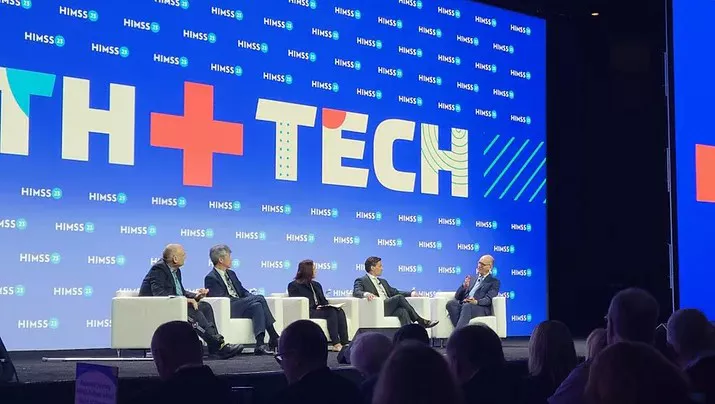
Taking control of data to improve health outcomes

At a glance
CRISP Shared Services (CSS) wanted to bring its near real-time health information exchange data processing in-house to increase speed and security, so it partnered with Slalom to build out their streaming data platform in Azure Databricks.
Impact
Now CSS can process over 1.7 million messages daily—in real time, with increasing quality—to drive better health outcomes across 10 states and counting.
Key Services
Industry
Health tech
Key Technologies / Platforms
- Databricks
- Microsoft Azure
Unified messaging for better outcomes
In the medical field, a split second can mean the difference between life and death, and that moment can often hinge on medical professionals having access to crucial information. Chesapeake Regional Information System for our Patients (CRISP) understands this, which is why it aims to keep its health information exchange (HIE)—a secure way of messaging that hospitals and clinics use to share patient information—at the cutting edge of efficacy and speed.
Since 2011, every hospital in Maryland has used CRISP as their data and messaging platform. The organization has since launched CRISP Shared Services (CSS), a nonprofit that has expanded CRISP HIE services to 10 states including Virginia, West Virginia, Alaska, and Connecticut, as well as the district DC.
At the core of CSS’s offerings are HL7 messages—information sent between disparate healthcare systems. For example, if a patient involved in a car accident ends up in a hospital on the other side of town from their primary care physician (PCP), their PCP can access that medical info sent via HL7 messages. This type of information sharing requires the utmost security, accuracy, and speed.
In the past, CSS was sending updates in batches. This approach limited access to real-time data and created dependencies that slowed down innovation. It also posed challenges for scalability and performance optimization as the organization grew.
“Often we were processing everything under the paradigm of a nightly bulk, sort of snapshot of data,” said Rhonda Moody, director of data insights at CSS. “And so sometimes there were use cases where more timely information would be very beneficial, and we couldn’t offer to support those.”
CSS wanted to bring its data processing in-house to drive better outcomes for patients at the individual level as well as public health and research purposes, while simplifying communication to physicians and payors. Building on the success of its earlier collaboration with Slalom, which resulted in a robust data platform for COVID tracking, the organization naturally turned to Slalom as a partner in enhancing and expanding its data capabilities.
CRISP and Slalom had previously implemented a data lake to analyze CRISP’s data faster and curate deeper insights. Now that the organization was beginning to process its messaging data in-house, there was a clear opportunity to process this extremely high volume of data with total control. It was soon decided that an Azure Data Lake solution would, again, be the ideal choice. But this time there was an additional goal: to build a streaming data platform that would process message data in near real time, allowing medical providers to receive messages close to instantaneously while maintaining security and privacy.


Streaming healthcare data at scale
The team got to work enhancing their advanced data platform for streamlining healthcare data management. The platform integrates four key components: a streaming engine for real-time data ingestion, a rules engine for linking hospital events and clinical results together to create a complete understanding of patient visits, a panel engine managing patient-provider relationships, and a notification engine delivering customized information—all linked to CSS’s long-standing integration capability to deliver custom information outbound. Using Databricks and Azure, the platform optimizes resource allocation and costs while providing flexible, near real-time data processing and delivery tailored to user-specific needs and preferences.
“Right now, with all of the streaming capabilities we have, the time from when we receive a file or message until it shows up in the portal is close to five minutes, which is really huge,” says Ayanjyoti Thakuria, senior data engineer and data insights technical lead at CSS.
The new architecture not only accelerated data processing but also enhanced data quality monitoring and reporting capabilities. “CSS was able to create a feedback loop for quality assurance that allowed them to better report on the data quality of the messages they received,” says Slalom principal Chris Mantz.
Another highlight is the ability to onboard new data sources and accommodate increasing message volumes and new healthcare partners without compromising on performance or requiring significant additional resources. “Our confidence and ability to scale are really big for us right now,” said Moody. “We’ve been in a growth period, and we’re anticipating that to continue. So making sure that whatever we build is very responsive and very scalable—those are two of the key components.”
Building on a mission
CSS’s mission is to appropriately and securely share data to facilitate care, reduce costs, and improve health outcomes, and the streaming data solution it built with Slalom lets it do just that.
“They’re definitely improving the speed and the quality of data that’s being shared with providers so that if you end up in the emergency room, they have a little bit of your background, they might know about some preexisting conditions, and they have context about you,” says Mantz. “I think that’s incredibly important.”
“There’s so much power in how easy it is to get the data, once it’s connected, to all the places it needs to go,” says Moody. Within the ecosystem of healthcare delivery and public health management, CSS is helping to bridge information gaps, enabling seamless communication across networks and driving tangible improvements in patient experiences and outcomes.




